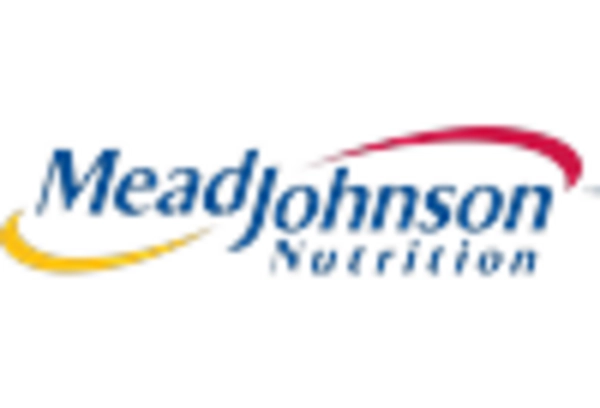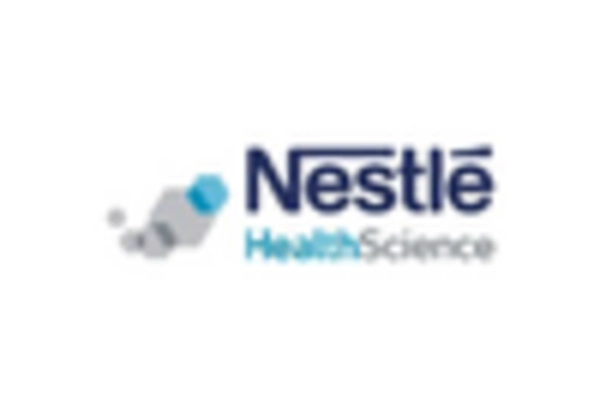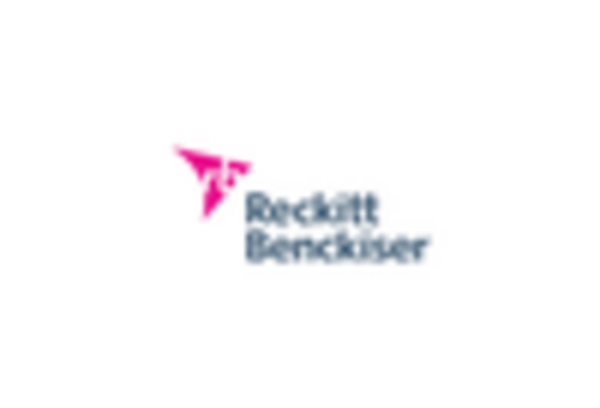Regulatory Support for Medical Foods
Regulatory support for medical foods is a critical driver for the medical foods market. In the United States, the FDA has established guidelines that facilitate the approval and marketing of medical foods, ensuring that they meet specific safety and efficacy standards. This regulatory framework provides manufacturers with a clear pathway to bring innovative products to market, thereby encouraging investment in research and development. Furthermore, the increasing recognition of medical foods as a legitimate treatment option for various health conditions is likely to enhance their acceptance among healthcare providers and patients alike. As a result, the market is anticipated to expand, with a projected growth rate of approximately 6% over the next few years, driven by this supportive regulatory environment.
Rising Incidence of Metabolic Disorders
The rising incidence of metabolic disorders is a significant factor influencing the medical foods market. Conditions such as obesity, diabetes, and metabolic syndrome are becoming increasingly prevalent in the United States, leading to a greater need for specialized nutritional interventions. Medical foods designed to manage these disorders are gaining traction as effective solutions for patients seeking to improve their health outcomes. Recent statistics indicate that nearly 40% of adults in the U.S. are classified as obese, highlighting the urgent need for targeted dietary strategies. This growing patient population is likely to drive demand for medical foods, with market analysts projecting a growth rate of around 7% in the coming years as healthcare providers seek effective dietary solutions for managing metabolic disorders.
Technological Advancements in Food Science
Technological advancements in food science are significantly impacting the medical foods market. Innovations in formulation and production processes are enabling the development of more effective and palatable medical foods. For instance, advancements in nutrient delivery systems and flavor enhancement techniques are making it easier for patients to adhere to prescribed diets. The integration of biotechnology in food production is also leading to the creation of specialized products that meet the unique needs of various patient populations. As a result, the market is witnessing an influx of new products that are not only nutritionally beneficial but also appealing to consumers. This trend is expected to contribute to a projected market growth of around 8% annually, as manufacturers invest in research and development to stay competitive in the evolving landscape of the medical foods market.
Increased Investment in Health and Wellness
Increased investment in health and wellness is emerging as a pivotal driver for the medical foods market. As consumers prioritize their health, there is a growing willingness to spend on products that promote well-being and prevent disease. This trend is reflected in the rising sales of medical foods, which are perceived as essential components of a proactive health strategy. The market is benefiting from a shift in consumer behavior, where individuals are more inclined to invest in specialized nutrition to support their health goals. Recent market analyses suggest that the medical foods market could experience a growth rate of approximately 9% annually, fueled by this increasing consumer focus on health and wellness. As more individuals seek out medical foods as part of their dietary regimen, the industry is poised for substantial expansion.
Growing Awareness of Nutritional Interventions
The medical foods market is experiencing a notable increase in awareness regarding the role of nutritional interventions in managing health conditions. As consumers become more informed about the benefits of tailored nutrition, there is a rising demand for products that cater to specific dietary needs. This trend is particularly evident among individuals with chronic illnesses, where specialized medical foods can play a crucial role in treatment. According to recent data, the market is projected to grow at a CAGR of approximately 7.5% over the next five years, driven by this heightened awareness. Healthcare professionals are increasingly recommending medical foods as part of comprehensive care plans, further propelling market growth. This shift towards recognizing the importance of nutrition in health management is likely to continue influencing the medical foods market in the coming years.

















Leave a Comment